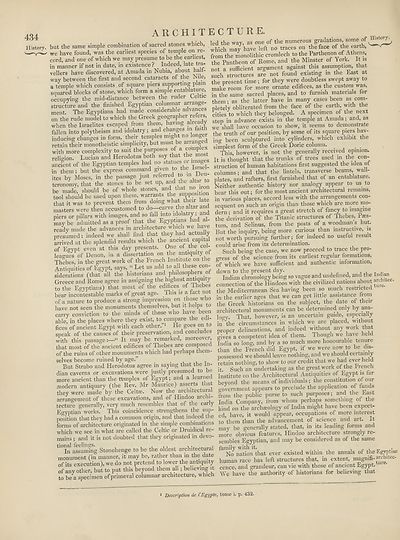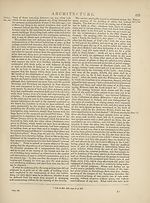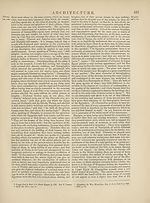Encyclopaedia Britannica > Volume 3, Anatomy-Astronomy
(442) Page 434
Download files
Complete book:
Individual page:
Thumbnail gallery: Grid view | List view

434
History.
ARCHITECTURE.
but the same simple combination of sacred stones which,
we have found, was the earliest species of temple on re¬
cord, and one of which we may presume to be the earliest,
in manner if not in date, in existence? Indeed, late tra¬
vellers have discovered, at Amada in Nubia, about halt-
way between the first and second cataracts of the Nile,
a temple which consists of square piers supporting plain
squared blocks of stone, which form a simple entablature,
occupying the mid-distance between the ruder Celtic
structure and the finished Egyptian columnar arrange¬
ment The Egyptians had made considerable advances
on the rude model to which the Greek geographer refers,
when the Israelites escaped from them, having already
fallen into polytheism and idolatry; and changes in fait
inducing changes in form, their temples might no longer
retain their monotheistic simplicity, but must be arrange
with more complexity to suit the purposes of a complex
religion. Lucian and Herodotus both say that the mos
ancient of the Egyptian temples had no statues or image
in them; but the express command given to the israe -
ites by Moses, in the passage just referred to ni Heu-
teronomy, that the stones to be set up, and the altar to
be made, should be of whole stones, and that no non
tool should be used upon them, warrants the supposition
that it was to prevent them from doing what then late
masters were then accustomed to do—carve the altar am
piers or pillars with images, and so fall into idolatry; an
may be admitted as a proof that the Egyptians had al¬
ready made the advances in architecture which we have
presumed: indeed we shall find that they had actually
arrived at the splendid results which the ancient capital
of Egypt even at this day presents. One of the col-
leagues of Denon, in a dissertation on the antiquity of
Thebes, in the great work of the French Institute on the
Antiquities of Egypt, says, “ Let us add to all these con¬
siderations (that all the historians and philosophers of
Greece and Rome agree in assigning the highest antiquity
to the Egyptians) that most of the edifices of Ihebes
bear incontestable marks of great age. This is a fact not
of a nature to produce a strong impression on those who
have not seen the monuments themselves, but it helps to
carry conviction to the minds of those who have been
able, in the places where they exist, to compare the edi¬
fices of ancient Egypt with each other.”1 He goes on to
speak of the causes of their preservation, and concludes
with this passage:—“ It may be remarked, moreovei,
that most of the ancient edifices of Thebes are composed
of the ruins of other monuments which had perhaps them¬
selves become ruined by age.” . T
But Strabo and Herodotus agree in saying that the In¬
dian caverns or excavations were justly presumed to e
more ancient than the temples of Egypt; and a learned
modern antiquary (the Rev. Mr Maurice) asserts that
they were made by the Celtae. Now the architectural
arrangement of these excavations, and of Hindoo archi¬
tecture generally, very much resembles that of the early
Egyptian works. This coincidence strengthens the sup¬
position that they had a common origin, and that indeed the
forms of architecture originated in the simple combinations
which we see in what are called the Celtic or Druidical re¬
mains ; and it is not doubted that they originated in devo¬
tional feelings. , . ^ ,
In assuming Stonehenge to be the oldest architectural
monument (in manner, it may be, rather than in the date
of its execution), we do not pretend to lower the antiquity
of any other, but to put this beyond them all; believing it
to be a specimen of primeval columnar architecture, which
led the way, as one of the numerous gradations, some of
which may have left no traces on the face of the earth,
from the monolithic cromlech to the Parthenon of Athens,
the Pantheon of Rome, and the Minster of York. It is
not a sufficient argument against this assumption, that
such structures are not found existing in the East at
the present time; for they were doubtless swept away to
make room for more ornate edifices, as the custom was,
in the same sacred places, and to furnish materials for
them; as the latter have in many cases been as com¬
pletely obliterated from the face of the earth, with the
cities to which they belonged. A specimen of the next
step in advance exists in the temple at Amada; and, as
we shall have occasion to show, it seems to demonstrate
the truth of our position, by some of its square piers hav¬
ing been sculptured into cylinders, which exhibit the
simplest form of the Greek Doric column.
This, however, is not the generally received opinion.
It is thought that the trunks of trees used in the con¬
struction of human habitations first suggested the idea of
columns; and that the lintels, transverse beams, wall-
plates, and rafters, first furnished that of an entablature.
Neither authentic history nor analogy appear to us to
bear this out; for the most ancient architectural remains,
in various places, accord less with the arrangements con¬
sequent on such an origin than those which are more mo¬
dern ; and it requires a great stretch of fancy to imagine
the derivation of the Titanic structures of Thebes, Fses-
tum, and Selinus, from the posts of a woodman s hut.
But the inquiry, being more curious than instructive, is
not worth pursuing further; for indeed no useful result
could arise from its determination.
Such being the case, we now proceed to trace the pro¬
gress of the science from its earliest regular formations,
of which we have sufficient and authentic information,
down to the present day. , . , , .-i T
Indian chronology being so vague and undefined, and the Indian
connection of the Hindoos with the civilized nations about »ec
the Mediterranean Sea having been so much restricted
in the earlier ages that we can get little assistance fiom
the Greek historians on the subject, the date ot their
architectural monuments can be determined only by ana¬
logy. That, however, is an uncertain guide, especially
in the circumstances in which we are placed, without
proper delineations, and indeed without any work that
Lives a competent idea of them. Though we have held
India so long, and by a so much more honourable tenure
than the French did Egypt, if we were now to be dis¬
possessed we should leave nothing, and we should certain y
retain nothing, to show to our credit that we had ever held
it. Such an undertaking as the great work of the Trench
Institute on the Architectural Antiquities of Egypt is far
beyond the means of individuals; the constitution of our
government appears to preclude the application of funds
from the public purse to such purposes; and the East
India Company, from whom perhaps something of the
kind on the archaeology of India might have been expect¬
ed, have, it would appear, occupations of more interest
to them than the advancement of science and art. It
may be generally stated, that, in its leading forms and
more obvious features, Hindoo architecture strongly re¬
sembles Egyptian, and may be considered as of the same
family with it. ... , ^
No nation that ever existed within the annals of the Egyptiai
human race has left structures that, in extent, magnifi-ardntec-
cence, and grandeur, can vie with those of ancient Egypt.
We have the authority of historians for believing that
1 Description de VEgypte, tome i. p- 432.
History.
ARCHITECTURE.
but the same simple combination of sacred stones which,
we have found, was the earliest species of temple on re¬
cord, and one of which we may presume to be the earliest,
in manner if not in date, in existence? Indeed, late tra¬
vellers have discovered, at Amada in Nubia, about halt-
way between the first and second cataracts of the Nile,
a temple which consists of square piers supporting plain
squared blocks of stone, which form a simple entablature,
occupying the mid-distance between the ruder Celtic
structure and the finished Egyptian columnar arrange¬
ment The Egyptians had made considerable advances
on the rude model to which the Greek geographer refers,
when the Israelites escaped from them, having already
fallen into polytheism and idolatry; and changes in fait
inducing changes in form, their temples might no longer
retain their monotheistic simplicity, but must be arrange
with more complexity to suit the purposes of a complex
religion. Lucian and Herodotus both say that the mos
ancient of the Egyptian temples had no statues or image
in them; but the express command given to the israe -
ites by Moses, in the passage just referred to ni Heu-
teronomy, that the stones to be set up, and the altar to
be made, should be of whole stones, and that no non
tool should be used upon them, warrants the supposition
that it was to prevent them from doing what then late
masters were then accustomed to do—carve the altar am
piers or pillars with images, and so fall into idolatry; an
may be admitted as a proof that the Egyptians had al¬
ready made the advances in architecture which we have
presumed: indeed we shall find that they had actually
arrived at the splendid results which the ancient capital
of Egypt even at this day presents. One of the col-
leagues of Denon, in a dissertation on the antiquity of
Thebes, in the great work of the French Institute on the
Antiquities of Egypt, says, “ Let us add to all these con¬
siderations (that all the historians and philosophers of
Greece and Rome agree in assigning the highest antiquity
to the Egyptians) that most of the edifices of Ihebes
bear incontestable marks of great age. This is a fact not
of a nature to produce a strong impression on those who
have not seen the monuments themselves, but it helps to
carry conviction to the minds of those who have been
able, in the places where they exist, to compare the edi¬
fices of ancient Egypt with each other.”1 He goes on to
speak of the causes of their preservation, and concludes
with this passage:—“ It may be remarked, moreovei,
that most of the ancient edifices of Thebes are composed
of the ruins of other monuments which had perhaps them¬
selves become ruined by age.” . T
But Strabo and Herodotus agree in saying that the In¬
dian caverns or excavations were justly presumed to e
more ancient than the temples of Egypt; and a learned
modern antiquary (the Rev. Mr Maurice) asserts that
they were made by the Celtae. Now the architectural
arrangement of these excavations, and of Hindoo archi¬
tecture generally, very much resembles that of the early
Egyptian works. This coincidence strengthens the sup¬
position that they had a common origin, and that indeed the
forms of architecture originated in the simple combinations
which we see in what are called the Celtic or Druidical re¬
mains ; and it is not doubted that they originated in devo¬
tional feelings. , . ^ ,
In assuming Stonehenge to be the oldest architectural
monument (in manner, it may be, rather than in the date
of its execution), we do not pretend to lower the antiquity
of any other, but to put this beyond them all; believing it
to be a specimen of primeval columnar architecture, which
led the way, as one of the numerous gradations, some of
which may have left no traces on the face of the earth,
from the monolithic cromlech to the Parthenon of Athens,
the Pantheon of Rome, and the Minster of York. It is
not a sufficient argument against this assumption, that
such structures are not found existing in the East at
the present time; for they were doubtless swept away to
make room for more ornate edifices, as the custom was,
in the same sacred places, and to furnish materials for
them; as the latter have in many cases been as com¬
pletely obliterated from the face of the earth, with the
cities to which they belonged. A specimen of the next
step in advance exists in the temple at Amada; and, as
we shall have occasion to show, it seems to demonstrate
the truth of our position, by some of its square piers hav¬
ing been sculptured into cylinders, which exhibit the
simplest form of the Greek Doric column.
This, however, is not the generally received opinion.
It is thought that the trunks of trees used in the con¬
struction of human habitations first suggested the idea of
columns; and that the lintels, transverse beams, wall-
plates, and rafters, first furnished that of an entablature.
Neither authentic history nor analogy appear to us to
bear this out; for the most ancient architectural remains,
in various places, accord less with the arrangements con¬
sequent on such an origin than those which are more mo¬
dern ; and it requires a great stretch of fancy to imagine
the derivation of the Titanic structures of Thebes, Fses-
tum, and Selinus, from the posts of a woodman s hut.
But the inquiry, being more curious than instructive, is
not worth pursuing further; for indeed no useful result
could arise from its determination.
Such being the case, we now proceed to trace the pro¬
gress of the science from its earliest regular formations,
of which we have sufficient and authentic information,
down to the present day. , . , , .-i T
Indian chronology being so vague and undefined, and the Indian
connection of the Hindoos with the civilized nations about »ec
the Mediterranean Sea having been so much restricted
in the earlier ages that we can get little assistance fiom
the Greek historians on the subject, the date ot their
architectural monuments can be determined only by ana¬
logy. That, however, is an uncertain guide, especially
in the circumstances in which we are placed, without
proper delineations, and indeed without any work that
Lives a competent idea of them. Though we have held
India so long, and by a so much more honourable tenure
than the French did Egypt, if we were now to be dis¬
possessed we should leave nothing, and we should certain y
retain nothing, to show to our credit that we had ever held
it. Such an undertaking as the great work of the Trench
Institute on the Architectural Antiquities of Egypt is far
beyond the means of individuals; the constitution of our
government appears to preclude the application of funds
from the public purse to such purposes; and the East
India Company, from whom perhaps something of the
kind on the archaeology of India might have been expect¬
ed, have, it would appear, occupations of more interest
to them than the advancement of science and art. It
may be generally stated, that, in its leading forms and
more obvious features, Hindoo architecture strongly re¬
sembles Egyptian, and may be considered as of the same
family with it. ... , ^
No nation that ever existed within the annals of the Egyptiai
human race has left structures that, in extent, magnifi-ardntec-
cence, and grandeur, can vie with those of ancient Egypt.
We have the authority of historians for believing that
1 Description de VEgypte, tome i. p- 432.
Set display mode to:
![]() Universal Viewer |
Universal Viewer | ![]() Mirador |
Large image | Transcription
Mirador |
Large image | Transcription
Images and transcriptions on this page, including medium image downloads, may be used under the Creative Commons Attribution 4.0 International Licence unless otherwise stated. ![]()
| Encyclopaedia Britannica > Encyclopaedia Britannica > Volume 3, Anatomy-Astronomy > (442) Page 434 |
|---|
| Permanent URL | https://digital.nls.uk/193763094 |
|---|
| Attribution and copyright: |
|
|---|---|
| Shelfmark | EB.16 |
|---|---|
| Description | Ten editions of 'Encyclopaedia Britannica', issued from 1768-1903, in 231 volumes. Originally issued in 100 weekly parts (3 volumes) between 1768 and 1771 by publishers: Colin Macfarquhar and Andrew Bell (Edinburgh); editor: William Smellie: engraver: Andrew Bell. Expanded editions in the 19th century featured more volumes and contributions from leading experts in their fields. Managed and published in Edinburgh up to the 9th edition (25 volumes, from 1875-1889); the 10th edition (1902-1903) re-issued the 9th edition, with 11 supplementary volumes. |
|---|---|
| Additional NLS resources: |
|

